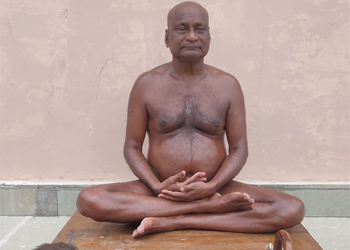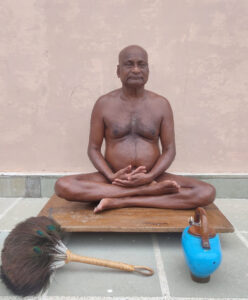We could successfully organize a total 67 presentations including plenary, invited and technical talks.
A special session was organized on 14 November on “Exploring the antiquity of Jainism in Asia, Africa and America” to offer a tribute to Late Shri Nirmal Kumar Ji Jain Sethi. This session as well as the session on history of Jainism were well attended by a large audience and sent their blessings.
The session wise bifurcation of talks is as follows.
- Space and Time: 7
- Content and Features in Dravya Sangrah and Agamas: 11
- Soul, Consciousness and Life: 9
- Bio-diversity in the Universe and Health: 6
- Concepts of Jainism in Canonical Texts: 4
- Karma and Pluralism: 7
- History and Antiquity of Jainism: 5
- Ethics and principles in Jain Agamas: 4
- Exploring Antiquity of Jainism in Asia, Africa and America – A Tribute to Late Shri Nirmal Kumar Jain Sethi: 7
- Technical Talks: 5
A few important points emerged out of the ocean churning/ brainstorm symposium as follows. However, you may also suggest the other points.
-
- Space and time:
Are the Dharm and Adharm Dravya responsible to delineate the Lokakash (cosmos) from the Alokakash (trans-cosmos). If so then the finite shape (even from the eternal time) of the Lokakash is due to this eternal pair of loka and aloka? If these two forces are not visible but playing key role in governing the motion of matter in the universe suggest that they must be having some physical form and being governed by physics of cosmos. The other important issue emerged regarding existing of multiverse (asankhyat brhamand). If multiverse concept is acceptable then each universe has similar pair of loka-aloka is an important question to be addressed. The questions related to Meru Parvat and Jambudwipa still exist and need to be satisfactorily to be addressed. Further, time (kaal) itself is in question if we consider the eternal universe. Mathematical representation of space and time is utmost necessary in terms of Jaina and modern science. In view of above plus many more curiosities it has been recommended by the participants and Chairperson to organize one International Seminar dedicating only to “Space and Time”. - Soul and Consciousness:
The soul is mysterious because of its metaphysical/ platonic/ spiritual form and thereby science is still not able to accept its existence in the physical body. How to convince the scientists is a big issue and how Jainism can help in this endeavor? We could explain the 47 shaktis (powers) of the soul but, again, how the science will accept it? Further, how these shaktis are connected to the consciousness and if possible their mathematical derivation. On the other hand consciousness is well accepted by science but the Jainism has much more detailed description in Agams, and how to link it to the modern science. The discussion on shrut, mati and other knowledges led to demand to organize a separate international seminar on this subject. - Ahimsa, Aparigraha and Anekantvad:
This topic was of great discussion throughout the symposium in different sessions. Is the Aparigraha an integral part of Ahimsa or not needs to be debated in context to religious, scientific and global aspects and, as well as detailed description of Aparigrah is required in terms of Paap and Punya. On the other hand, review of Anekantvad is utmost necessary in global welfare concept. According to Jain agams the Anekantvad stands upon vision based on “Dravya, Kshetra, Kaal and Bhaav”, and now in present world issues, does it require to be reviewed or it may help in present form is a big challenge? - Paap and Punya:
During the question hour in different sessions various aspects of Paap and Punya caused a blue murder and audience asked to clarify how sometimes Punya may get converted to even worse than Paap? Those who perform Punya tasks regularly with full efforts but feel “Pramada (pride), or require popularity/ publicity through Boli or posters/ banners etc. convert their virtuous deeds into worse than sin. On the other hand, it is but natural that one who does virtuous works always get publicity and popularity as well as feel naturally some pride, and upon realization the above fact nobody will take initiative for the Punyas. These questions need to be addressed in the preview of Jainism and global challenges. Is the “Gupt-daan” (recondite donation or offerings) could be a solution or not to be discussed. Therefore, one day dedicated seminar may be organized, and outcome may be documents and disseminated globally for follow-up and practice. - Path of Salvation and Moksha:
It was discussed in depth whether truly now it is not possible to achieve Keval Gyana and salvation/moksha or the process itself required for that is now not known because of various reasons. In the last ten thousand years Jainism witnessed at least 5 Tirthankars. The Nirgranth tradition (dominated by nude monks relative to followers) had some set rules of various forms of meditation, cogitation, perseverance, tenacity, penance to enhance/ improve the “Gunsthana” and then finally to achieve the Keval Gyana and salvation. Somehow that art/ technology was lost after Tirthankar Mahavir and/ or Bhadrabahu Swamiji. This needs further in-depth discussion in the light of various postures of meditation and perseverance available in the museums of South America and Africa as well as studying the history of Mayans. Further, the essence of Sallekhana needs to be discussed. - History and Antiquity of Jainism:
It was felt very seriously that we are not aware about history and antiquity of our own religion and that is the reason others put finger on Jainism to be eternal. In fact no significant research work has been done of international repute/ recognition. The young generation and intellectuals who never knew enriched history of Jainism felt very sorry and anger about their parents/ Munis and society of recent and previous past and strongly suggested to organize small or large level many seminars on this task. While recognizing the all above issues to be of importance it was realized that in order to address them the history and antiquity must be known. It was strongly recommended that an international symposium must be organized separately dedicating to Antiquity of Jainism. - Language and scripts:
While exploring Jainism in other countries over the globe language appeared as big constraint. In many countries 99% people do not know English, and the Hindi is out of question. However, on the other hand, in few countries a very little number of universities run course of philosophy/ language where sometimes Jainism is also taught. Further, the old canonical texts/ manuscripts are in Pali, Apbransh/ Prakrit etc. which are known to very few scholars in India and outside to almost insignificant number. On one hand it was mentioned in the symposium we have more than one million scripts exist in India, and perhaps a similar number in Europe in general and in Udine University, Italy in particular, but, on the other hand, where are readers and interpreters? Thus this issue of language constraint and meaningful interpretation of canonical texts is of prime importance. A pilot project type work needs to be taken in hand by Jains of all over the globe. A strategic plan, funding, implementation etc. needs to be discussed at an appropriate forum. - Views of Generation Next:
It was felt to discuss in greater details the various particles, their group and characteristics as this subject guide to modern science for further investigation. Further, discussion on the nature of karma vargana and tejas vargana is utmost necessary in general and in context to their bondage with soul. The soul is always pure, and, if so, then how it works to be compared in the light of science. Presentations were basically dedicated considering the soul as spiritual. The young generation demands scientific approach of this aspect as well as many other aspects such as how tejas vargana/ particles for the current or magnetic field and various issues related to space and time. Their clear cut opinion is on the requirement of applied Jainism instead of theoretical concepts. Also they showed interest in the history and antiquity of Jainism, which, perhaps, may attract them towards the Religion.
- Space and time:
Post Symposium lots of calls received demanding videos of all the sessions and of each speaker as well as faster publication of the proceedings of the symposium.
I express my sincere thanks to you all. All the scholars gave extremely good presentation, and the Chairperson of the sessions discharged their responsibility meticulously with full wisdom and Scholarly. I humbly say to them – magnificent with respects.
Unfortunately, 3 talks could not be organized on 11 November due to technical problem in one of the links. The inaugural session was organized meticulously, which included blessing address by Acharyshree Kanaknandi Ji Gurudev, Chief Guest address by Shri Prakash Chandra Ji Badjatya, Rashtriya Mahamantri, SBDJM, and One special Plenary lecture by Prof. Jitendra B. Shah, Chairman, SoC and an Invited talk by Dr. Neelam Jain. In view of large number of participants and their presentation parallel sessions were organized. We express our sincere thanks to the chief guests and guest of honors for accepting kind invitation and blessing the symposium.
The symposium, on the one hand, was also blessed by Ganadhipati Gandharacharya Shri Kunthu Sagar Ji, Acharya Shri Devnandi Ji, and Ganini Aaryika Gyanmati Mataji, and on the other hand was actively participated by presenting the papers by highly intellectual monks – sadhu and sadhvis viz. Acharya Anubhavsagar ji, Munishree Mahendra Kumar Ji, Muni Amoghkirti Ji, Aaryika Sudradhmati Mataji, Samani Chaitanya Prajnaji, Kshullak Shri Dhyansagar Ji and Kshullika Vismitashree Mataji.
Prof. (Dr.) Rajmal Jain Kothari, FRAS, FGSA
Co-Chair and Convener




How to get your magzine